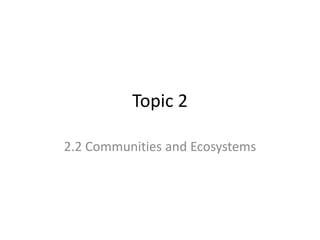
Summary of topic 2.2
- 1. Topic 2 2.2 Communities and Ecosystems
- 2. Ecosystem Structure • There are 3 main biotic components in any ecosystem: – Producers • Plants, algae and cyanobacteria • They are able to create food using sunlight energy • Also referred to as photoautorophs – Consumers • Obtain energy through eating other organisms • They do not possess chlorophyll and can’t photosynthesise • Also referred to as heterotophs • They may be herbivores or carnivores – Decomposers • Bacteria and fungi 1 2 3 • Obtain food though the breakdown of dead organic matter • Create humic material and are important in recycling nutrients • Some bacteria are chemoautotrophic decomposers (they use a similar process to photosynthesis which uses energy from oxidation reactions rather than sunlight)
- 3. Food Webs A simplified food web for savannah biome
- 4. Energy Flow • Photosynthesis • Respiration 6CO2 + 6H2O C6H12O6 + 6O2 C6H12O6 + 6O2 6CO2 + 6H2O • Energy flow through an ecosystem occurs by 2 processes:
- 5. Energy Flow Photosynthesis Respiration Inputs Outputs Transformations Process Glucose, O2Light Energy, H2O, CO2 Glucose, O2 Energy, H2O, CO2 Light Energy Chemical Energy Chemical Energy Kinetic Energy + Heat Chlorophyll traps light energy, this energy used to split water molecules, H from water combined with CO2 to produce glucose Oxidation reactions inside cells break down glucose to release energy
- 6. Energy Flow • The sun is the source of energy for the producers in nearly all of the food webs on Earth • This is because they are usually dependent on photosynthesis • However, between 1977 and 1979 scientists from the Woods Hole Oceanographic Research Institution, using the submersible Alvin, confirmed the existence of deep-sea hydrothermal vents and communities in which the producers are use chemosynthesis not photosynthesis (they live in complete darkness) Bill Nye - Hydrothermal vent communities
- 7. Energy Flow • About half of the Sun’s total radiation is visible light • Only visible light is useful for photosynthesis • Producers use very little of the visible light available to produce biomass (about 0.06% of the Sun’s total radiation is captured by producers) – The remainder is reflected, transmitted or is not the correct wavelength of light for photosynthesis. Photosynthesis itself is not an efficient process (typically 0.1 - 2.0% efficient) Why do you think photosynthesis hasn’t evolved to become a more efficient process?
- 8. Energy Flow • Producers make energy available to consumers in the form of stored chemical energy (glucose) • This energy is lost as it passes through each trophic level due to respiration and defaecation (typically 90% is lost between each level) • Eventually all of the initial available energy is lost by being converted into heat which radiates away from the Earth. The Sun re-radiates energy to the Earth (which is therefore an Open System) Can you see the relevance of the Second Law of Thermodynamics to ecosystems?
